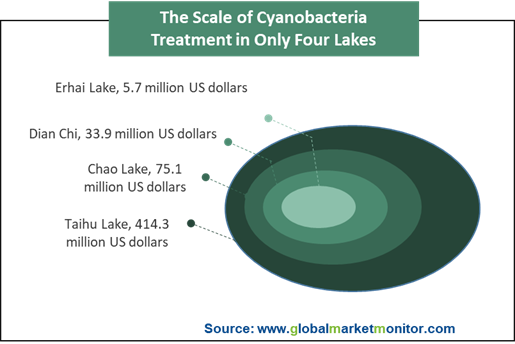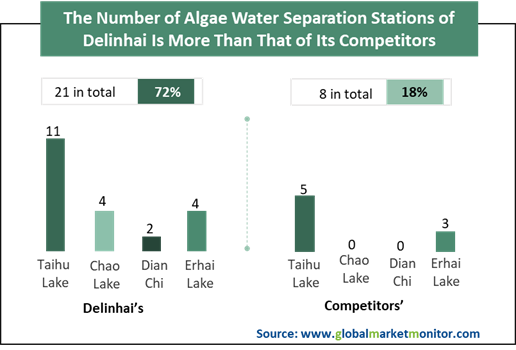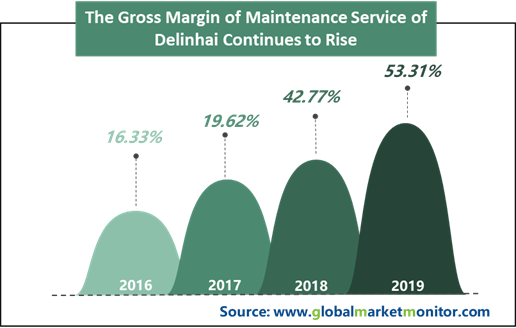Cyanobacteria is one of the simplest and most primitive single-celled prokaryotes and also the most widely distributed and adaptable photosynthetic autotrophic organism on the earth. Most of the cells are blue-green and are widely distributed on land and water, which like high temperatures, strong light, and more static freshwater bodies, especially in organic matter.
Under normal circumstances, the existence of cyanobacteria will not adversely affect water bodies. However, once it multiplies in a short period and the number increases exponentially to the extent that it covers a large area of the water surface, it will have a serious impact on the water body, resulting in an imbalance of the ecosystem and affecting the growth of fish and other algae. Besides, when cyanobacteria die, they decompose and consume too much oxygen, leading to the death of other organisms due to lack of oxygen, and will emit a fishy smell and appear blue-white, causing the water body to become odorous and turbid, which seriously pollutes the water source. Also, the phycotoxin contained in cyanobacteria, as a strong liver tumor promoter, is one of the three major culprits of liver cancer. Long-term drinking of water from cyanobacteria outbreaks will seriously damage the liver system.
Cyanobacteria Management Is A Fast-Growing Track with Great Market Potential
The treatment of lake eutrophication has become one of the most prominent problems in the management and protection of lake environment in China, where two-thirds of the freshwater lakes are concentrated in the middle and lower reaches of the Yangtze River, but most of them are shallow lakes. Due to the rapid economic development and inappropriate utilization of lake resources in the past 20 years, most of these lakes have been eutrophication. Among the 106 key lakes monitored for eutrophication, 7 lakes were in a moderate eutrophication state, accounting for 6.6%; 19 lakes were in a mild eutrophication state, accounting for 17.9%; the remaining lakes did not show eutrophication.
Cyanobacteria treatment is an emerging industry. During the "13th Five-Year Plan" period, the cyanobacteria treatment market for the four major lakes exceeded 3.7 billion, among them, Taihu Lake accounts for 2.9 billion yuan, Chaohu Lake accounts for 526 million yuan, Dianchi Lake accounts for 237 million yuan, and Erhai Lake accounts for 40 million yuan.

However, the outbreak of cyanobacteria in other eutrophic lakes in China has not been significantly alleviated. In addition to the six major lakes, the cyanobacteria treatment also ranges from 19 with cyanobacteria blooms to 60 lakes with eutrophication problems. With economic development, more and more eutrophic lakes carry out cyanobacteria treatment, and the domestic market for cyanobacteria treatment is broad, in which the cyanobacteria treatment is still urgent. It is expected that during the "14th Five-Year Plan" period, there will still be a high investment demand for lake and reservoir management.
The Treatment of Lake Eutrophication Is A Long and Continuous Process
Lake Biwa in Japan has gone through a long-term management. With an area of approximately 670 square kilometers, Lake Biwa is the largest freshwater lake in Japan, whose geographical location is very important, as one of the fastest-growing areas in Japan in recent years and one of the main sources of drinking water for residents. In the 1960s, Japan's economy grew rapidly and the environment of Lake Biwa was severely polluted and destroyed-water quality declines, red tides, and green algae occurred from time to time. In 1977, a large-scale red tide occurred in Lake Biwa, which shocked the entire Japanese society.
The Control of Lake Biwa eutrophication is divided into two stages. The first stage lasted 25 years, during which significant achievements were the effective use of water resources of Lake Biwa and the prevention of flood and housing. The second phase began in 1999 until now, in which the main goals are water quality protection, water conservation, and natural environment protection. At present, the eutrophication of Lake Biwa has been effectively controlled. As of 2006, the comprehensive renovation of Lake Biwa lasted for 35 years, with a total investment of about 180 billion yuan and an average annual investment of about 4.9 billion yuan.
Turning to the domestic situation, the Taihu Lake water crisis that broke out at the end of May 2007 has aroused widespread concern from all walks of life. The State Council approved and implemented the "Overall Plan for the Comprehensive Treatment of Water Environment in the Taihu Lake Basin", which was revised in 2013 and proposed a long-term goal to maintain the permanganate index and ammonia nitrogen stably at Class II, total phosphorus to reach Class III, and total nitrogen to reach Class V in 2020. Data show that in 2019, the average water quality of Taihu Lake was Grade IV, with a comprehensive nutritional status index of 55.6, in which permanganate index, ammonia nitrogen, total phosphorus, and total nitrogen are respectively Class II, Class I, Class IV and Class III. The total phosphorus index has not yet reached the standard, and there is still a long way to go. During the 10 years from 2007 to 2017, the total cyanobacteria salvage of Wuxi was 11.79 million tons, accounting for more than 90% of the cyanobacteria salvage in Jiangsu Province, which takes a dominant position of the salvage of cyanobacteria in Taihu Lake. In the 13th Five-Year Plan of Taihu Lake Basin Management in Jiangsu Province, 51.5 billion yuan is planned to be invested, of which the disposal and resource utilization projects of blue algae and silt are planned to be invested 3.2billion yuan, accounting for 6.2%.
Delinhai is currently the only domestic professional that has successfully conducted cyanobacteria treatment and prevention around Taihu Lake, Chaohu Lake, and Dian Chi, with large scale, industrialized, and harmless disaster features.
In an absolute leading position, there are fewer competitors. Taking the algae water separation station projects of the four major lakes as an example, the number of algae water separation stations of Delinhai of the four major lakes accounted for 72% of the total market scale. Among them, the separation stations in Chaohu and Dianchi reached 100%, and the lowest proportion of Erhai Lake also reached 57%.

in operation and maintenance increased to 31.32%. Besides, the gross margins of operation and maintenance services from 2016 to 2019 were 16.33%, 19.62%, 42.77%, and 53.31%, respectively, showing a significantly accelerated upward trend.The first quarter of 2020 achieved a net profit of 14 million yuan, a year-on-year increase of 16.3%. The decline in growth was mainly due to the delay of some sales and purchase orders due to the epidemic, and most of the company's revenue was concentrated in the second half of the year. Considering that the company's current orders are over 900 million yuan and the orders are sufficient, the annual performance is still expected to continue the rapid growth trend.

Custom Reporting
https://www.globalmarketmonitor.com/request.php?type=9&rid=0
We provide more professional and intelligent market reports to complement your business decisions.